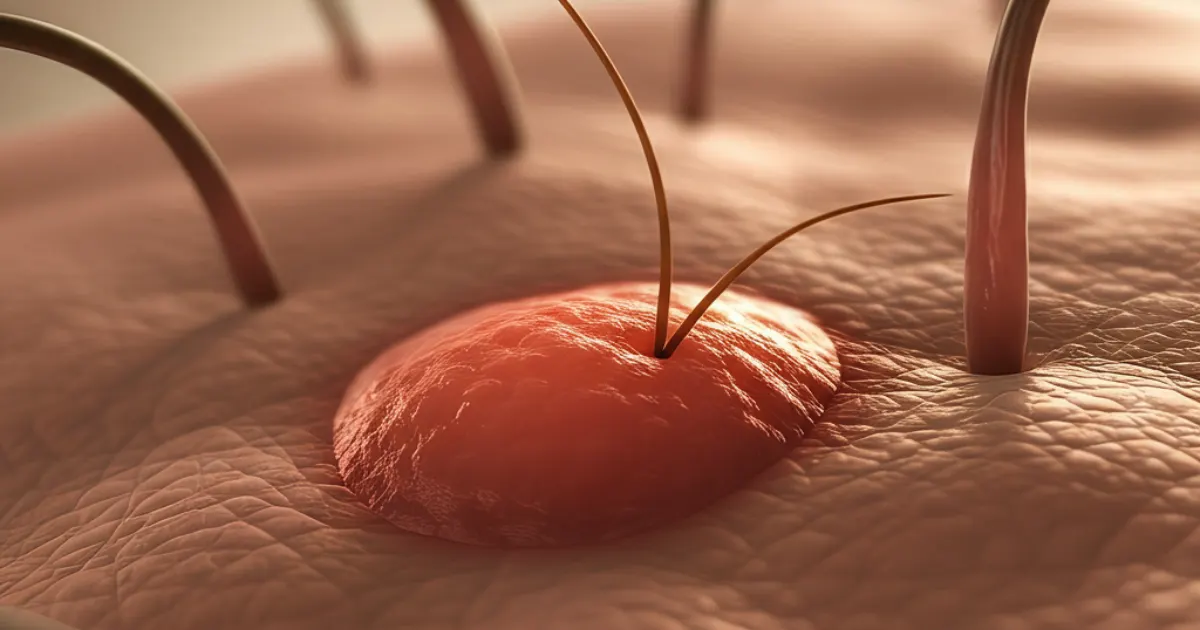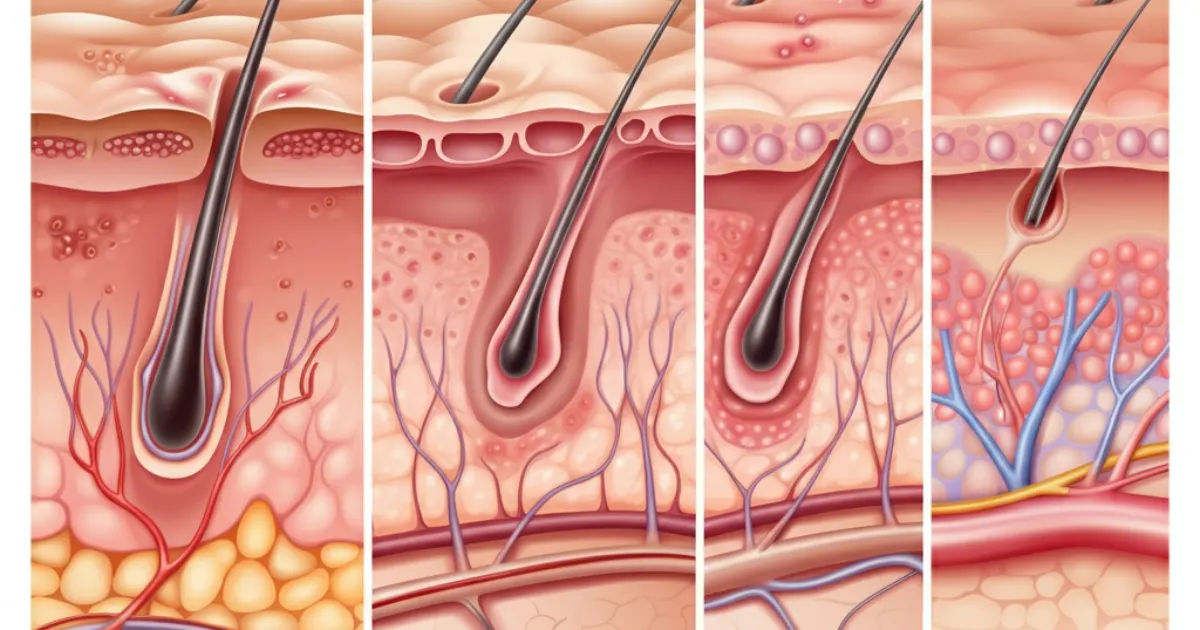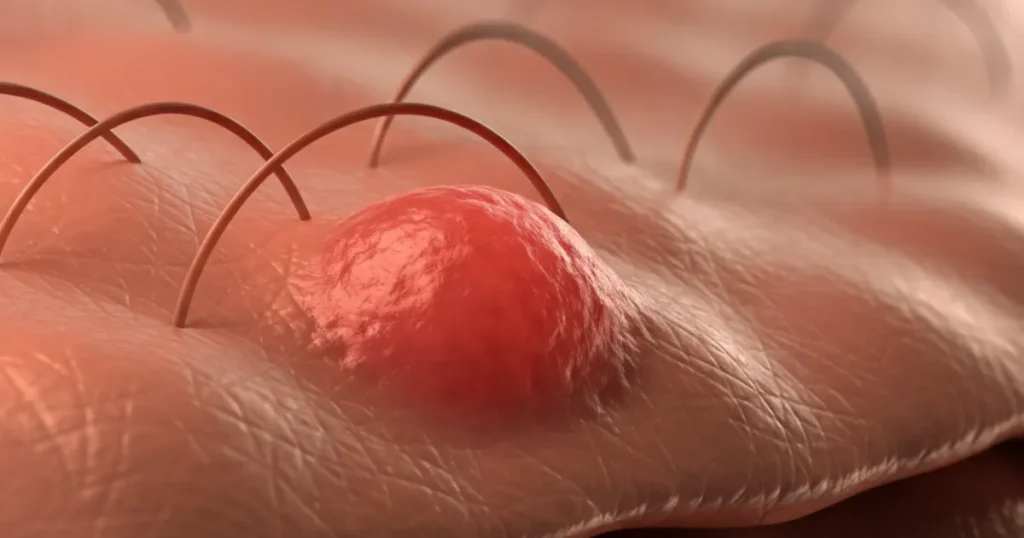Ingrown hairs are a common skin issue that can affect anyone, regardless of age, gender, or skin type. They often appear after shaving, waxing, or other hair removal methods, but they can also occur naturally. If you’ve ever noticed a red, bumpy spot on your skin that’s sore or itchy, you might be dealing with an ingrown hair. In this article, we’ll explain what an ingrown hair looks like, its symptoms, how to identify it, and tips for managing it. Let’s dive in!
What Is an Ingrown Hair?
An ingrown hair happens when a hair curls back or grows sideways into the skin instead of growing outward. This can cause irritation, redness, and sometimes pain. Ingrown hairs are most common in areas where hair is removed, like the face, legs, armpits, or bikini area, but they can appear anywhere hair grows.
Think of it like a hair getting “stuck” under the skin. Instead of poking out as it should, the hair loops back or grows horizontally, causing the skin to react. This is why ingrown hairs often look like small pimples or bumps.
What Does an Ingrown Hair Look Like?

If you’re wondering, “What does an ingrown hair look like?” here’s a clear picture:
- Small, red bumps: Ingrown hairs often appear as tiny, red, or pink bumps on the skin. They might look like pimples or acne at first glance.
- Visible hair: You may see a hair trapped under the skin, either curled or growing sideways. Sometimes, the hair is barely visible, but you can feel it.
- Swelling or inflammation: The area around the ingrown hair might be slightly swollen or raised.
- Pus-filled bumps: In some cases, an ingrown hair can form a small, white, or yellowish pus-filled bump, similar to a pimple.
- Dark spots: For people with darker skin tones, ingrown hairs may cause hyperpigmentation, leaving a dark spot around the bump.
- Itchy or tender spots: The bump may feel itchy, sore, or sensitive to the touch.
Ingrown hairs can vary in appearance depending on your skin type, the area of the body, and whether the hair is infected. They’re usually small, ranging from the size of a pinhead to a small pea.
Common Symptoms of Ingrown Hairs
Recognizing the symptoms of an ingrown hair can help you identify it quickly. Here are the most common signs:
- Redness: The skin around the hair may look red or irritated, especially if you’ve recently shaved or waxed.
- Itching: Ingrown hairs often cause an itchy sensation, making you want to scratch the area.
- Pain or tenderness: The bump may feel sore, especially when touched or pressed.
- Swelling: A slight swelling or raised bump is common as the skin reacts to the trapped hair.
- Pus or fluid: If the ingrown hair becomes infected, you might notice pus or a small amount of clear fluid.
- Burning sensation: Some people feel a mild burning or stinging around the affected area.
- Darkening of the skin: Over time, repeated ingrown hairs can cause dark spots, especially in people with darker skin tones.
If you notice these symptoms, especially after hair removal, there’s a good chance you’re dealing with an ingrown hair.
Where Do Ingrown Hairs Appear?
Ingrown hairs can show up anywhere hair grows, but they’re more common in certain areas, including:
- Face and neck: Common in men who shave their beards or women who pluck facial hair.
- Legs: Frequent after shaving or waxing the legs.
- Bikini area or pubic region: A common spot due to coarse, curly hair and frequent hair removal.
- Armpits: Shaving or waxing can lead to ingrown hairs here.
- Scalp: Rare, but possible, especially in people with curly hair or those who shave their heads.
Curly or coarse hair types are more prone to ingrown hairs because these hairs are more likely to curl back into the skin. However, anyone can get them, regardless of hair type.
How to Identify an Ingrown Hair
Wondering how to tell if that bump is an ingrown hair or something else, like a pimple or an infection? Here are some tips to help you identify an ingrown hair:
- Look for a trapped hair: Check if you can see a hair curled or growing sideways under the skin. This is a key sign of an ingrown hair.
- Check the timing: Did you recently shave, wax, or pluck hair in the area? Ingrown hairs often appear a few days after hair removal.
- Compare to acne: Ingrown hairs usually have a hair visible or feel like a hard bump under the skin, while pimples are often softer and filled with pus.
- Feel for tenderness: Ingrown hairs are often tender or itchy, but not as painful as a boil or cyst.
- Monitor for infection: If the bump is very red, warm, or leaking pus, it might be an infected ingrown hair, which requires extra care (more on this later).
If you’re still unsure, try gently cleaning the area with warm water and a mild soap. This can make the hair more visible and help reduce swelling.
Ingrown Hair vs. Other Skin Conditions

| Feature | Ingrown Hair | Acne (Pimples) | Folliculitis | Cyst | Boil (Furuncle) |
|---|---|---|---|---|---|
| Cause | Hair grows back into the skin after shaving or waxing | Clogged pores with oil, bacteria, and dead skin cells | Infection or irritation of hair follicles | Blocked gland or follicle filled with fluid or pus | Bacterial infection in a hair follicle |
| Appearance | Small, red bump often with visible hair loop or tip | Red, inflamed bump, often with a white center | Red pimples with or without pus; clustered follicular bumps | Firm, round, painless or painful lump under the skin | Painful, red bump that becomes pus-filled and swollen |
| Pain Level | Mild to moderate, sometimes itchy | Mild to moderate discomfort | Mild to moderate, occasionally itchy or tender | Varies from none to moderate pain | Moderate to severe, throbbing pain |
| Location | Common in shaved/waxed areas (face, legs, bikini line) | Face, back, shoulders, chest | Anywhere with hair follicles | Anywhere under the skin | Common in armpits, buttocks, neck, thighs |
| Onset | Shortly after hair removal | Develops over time due to clogged pores | Can appear suddenly or after irritation | Slowly develops over days or weeks | Rapid onset over a few days |
| Pus Formation | May have a small amount if infected | Common in whiteheads/pustules | Yes, often has a small amount of pus | Can contain thick fluid if it ruptures | Usually filled with pus |
| Treatment | Warm compress, exfoliation, topical antiseptics | Over-the-counter acne meds, proper skincare | Antibacterial washes, topical or oral antibiotics | Warm compress, possible drainage if persistent | Warm compress, drainage, oral antibiotics if severe |
| Scarring Potential | Low if not picked or infected | Possible with frequent picking or severe cases | Low to moderate | Possible if burst or not treated properly | Higher risk if not drained properly |
| Infectious? | No (unless secondarily infected) | No | Can be mildly contagious if bacterial | No | Yes, caused by bacterial infection |
| Prevention Tips | Avoid close shaving, exfoliate, moisturize | Regular cleansing, non-comedogenic products | Keep area clean, avoid friction | Unknown – not always preventable | Good hygiene, avoid shared personal items |
What Causes Ingrown Hairs?
Understanding what causes ingrown hairs can help you prevent them. Common causes include:
- Shaving: Using a dull razor or shaving too closely can cause hairs to grow back into the skin.
- Waxing or plucking: These methods can leave hair follicles open, allowing hairs to grow sideways.
- Curly or coarse hair: Naturally curly hair is more likely to curl back into the skin.
- Dry skin: Dead skin cells can clog hair follicles, trapping hairs.
- Tight clothing: Wearing tight clothes can rub against the skin, pushing hairs back in.
By addressing these causes, you can reduce your chances of getting ingrown hairs.
How to Treat an Ingrown Hair
Most ingrown hairs go away on their own within a week or two, but you can help them along with these simple steps:
- Stop hair removal: Avoid shaving, waxing, or plucking the area until the ingrown hair heals.
- Warm compress: Apply a warm, damp cloth to the bump for 10–15 minutes, 2–3 times a day. This softens the skin and helps the hair come out.
- Exfoliate gently: Use a mild exfoliating scrub or a soft washcloth to remove dead skin cells, which can help free the hair.
- Use tweezers (carefully): If the hair is close to the surface, you can gently lift it out with clean, sterilized tweezers. Don’t dig or force it, as this can cause scarring.
- Apply a soothing cream: Use an over-the-counter hydrocortisone cream or aloe vera to reduce redness and swelling.
Avoid picking or squeezing the bump, as this can lead to infection or scarring.
When to See a Doctor
Most ingrown hairs are harmless, but you should see a doctor if:
- The bump is very painful, red, or warm to the touch.
- You see signs of infection, like pus, fever, or swelling that spreads.
- The ingrown hair doesn’t improve after 1–2 weeks.
- You get ingrown hairs frequently, as this could be a sign of an underlying skin issue.
A doctor may prescribe an antibiotic cream for infections or recommend professional hair removal methods to prevent future ingrown hairs.
How to Prevent Ingrown Hairs
Preventing ingrown hairs is easier than treating them. Try these tips:
- Use a sharp razor: Always shave with a clean, sharp razor to avoid tugging at hairs.
- Shave in the direction of hair growth: This reduces irritation and the chance of hairs growing back into the skin.
- Moisturize regularly: Keep your skin hydrated to prevent dry, dead skin from clogging follicles.
- Exfoliate weekly: Gently exfoliate your skin to remove dead cells and keep follicles clear.
- Consider laser hair removal: For chronic ingrown hairs, laser hair removal can reduce hair growth over time.
Ingrown Hairs and Skin Types
People with curly or coarse hair, such as those of African, Hispanic, or Mediterranean descent, are more prone to ingrown hairs due to the hair’s natural curl pattern. However, anyone can get them. For darker skin tones, ingrown hairs can lead to hyperpigmentation (dark spots), which may take longer to fade. Using gentle skincare products and avoiding irritation can help manage this.
FAQs About Ingrown Hairs
Q: Can ingrown hairs go away on their own?
A: Yes, most ingrown hairs resolve on their own within a week or two if you avoid irritating the area.
Q: Are ingrown hairs dangerous?
A: They’re usually harmless but can become infected if picked or scratched. Seek medical help if you notice signs of infection.
Q: Can I pop an ingrown hair?
A: No, popping can cause scarring or infection. Instead, use a warm compress or exfoliate to help the hair come out.
Q: How long do ingrown hairs last?
A: They typically last 1–2 weeks but can persist longer if irritated or infected.
Conclusion
Ingrown hairs are a common, usually harmless skin issue that can be easily identified by their appearance and symptoms. Look for small, red, or pus-filled bumps with a visible hair trapped under the skin. Symptoms like itching, tenderness, or redness are also telltale signs. By understanding what an ingrown hair looks like and how to treat it, you can manage them effectively at home. If you’re unsure or the bump worsens, consult a healthcare professional for advice.
With proper care and prevention, you can keep your skin smooth and free from ingrown hairs. Have you dealt with ingrown hairs before? Share your tips in the comments below!

